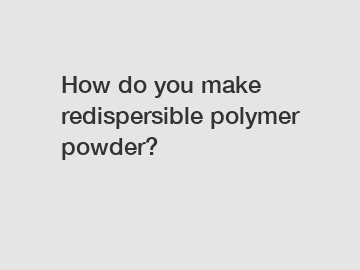Mar. 12, 2024
Chemicals
AiBeiDe are exported all over the world and different industries with quality first. Our belief is to provide our customers with more and better high value-added products. Let's create a better future together.
Redispersible polymer powder is a vital ingredient in the construction industry, used in a wide range of applications such as tile adhesives, grouts, self-leveling compounds, and waterproofing membranes. It is essentially a free-flowing white powder that can easily be mixed with water to form a stable emulsion. But have you ever wondered how this versatile powder is made? In this blog, we will explore the process of making redispersible polymer powder and the crucial steps involved in its production.
The production of redispersible polymer powder begins with the selection of high-quality polymer emulsions. These emulsions are typically made from a variety of synthetic polymers such as ethylene-vinyl acetate (EVA), vinyl acetate-ethylene (VAE), and acrylics. The choice of polymer emulsion will depend on the specific properties required for the end product, such as flexibility, adhesion, and water resistance.

Once the polymer emulsion has been selected, it is then dried using a special spray drying process. This process involves atomizing the emulsion into a fine mist and then drying it using hot air, resulting in the formation of small spherical particles. The size of these particles can be controlled to achieve the desired properties of the redispersible polymer powder.
During the spray drying process, additional ingredients such as dispersants, plasticizers, and anti-caking agents may be added to improve the performance of the powder. These additives help to enhance the dispersion of the powder in water, increase its flexibility, and prevent clumping during storage.
After the drying process is complete, the redispersible polymer powder is then sieved to remove any oversized particles and ensure a consistent particle size distribution. This step is crucial to ensure the uniformity and quality of the powder, as any variations in particle size can affect its performance in various applications.
Once the powder has been sieved, it is then stored in a controlled environment to prevent moisture absorption and maintain its stability. Proper storage conditions are essential to ensure the long-term effectiveness of the redispersible polymer powder.
In addition to the manufacturing process, the quality of the raw materials used in the production of redispersible polymer powder is also crucial. High-quality polymer emulsions, additives, and other ingredients are essential to produce a powder with the desired properties and performance characteristics.
Overall, the production of redispersible polymer powder is a complex and precise process that requires careful attention to detail and adherence to strict quality control measures. From the selection of raw materials to the drying process and storage, every step plays a critical role in ensuring the effectiveness and reliability of the final product.
In conclusion, redispersible polymer powder is a versatile and essential material used in a wide range of construction applications. Understanding the process of how it is made can provide valuable insights into its properties and performance characteristics. With the right combination of high-quality materials and precise manufacturing techniques, redispersible polymer powder can help to improve the durability, flexibility, and adhesion of various construction products.
If you want to learn more, please visit our website hpmc manufacturer.
Previous: What is zirconium phosphate used for?
Next: Revolutionizing the NBR Latex Industry: Is Sustainability Achievable?
If you are interested in sending in a Guest Blogger Submission,welcome to write for us!
All Comments ( 0 )